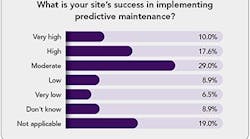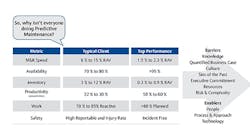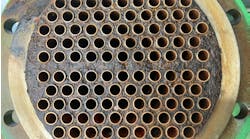Predictive Maintenance Efforts Boast Uneven Success
Online polling conducted by CP late last year shed some light on the success of plants in achieving predictive maintenance. While more than a quarter of respondents said their sites had attained high or very high success, a larger number reported only moderate success, and over 15% called success low or very low (Figure 1). Several reasons account for the disparate results, say vendors, who also suggest a number of ways to improve outcomes.
Operating companies generally realize that predictive maintenance promises greater uptime and, thus, increased production capacity, along with lower costs from planned maintenance versus reacting to asset failure or performing unnecessary work, notes Michael Risse, vice president of Seeq (Seattle, Wash.). The main barrier to adoption is supporting the lifecycle, he says. “Chemical companies need to determine what data matters, collect it, find the event/predictive signal that matters, and take action on it in timely fashion. They need to get all the pieces in place from technical to process details of who does what, and often more importantly determine how to use predictions in the most profitable manner.”
Figure 1. Only about one quarter of respondents to a recent CP online poll said their sites had achieved high or very high success.
This could be as simple as monitoring and analyzing data already collected or as complex as implementing a whole new set of wireless sensors with a cloud structure for data storage and analysis, he notes. Meanwhile, costs of advanced analytics are coming down and the simplicity of plug-and-play deployments is increasing — prompting pressure from executives to leverage these new approaches.
Even so, Risse believes the real question is, given equipment health status and profitability/cost data, how can plant staff decide in the very short term about what to do with these insights (Figure 2)?
“Yes, maintenance needs to be performed at some point, but should they shut down the asset, line or plant now, or should they delay it? Can they work around it for a period of time, or must the work be done now? The data is already overwhelming. More of it because it’s cheaper won’t make it better; what makes data better is knowing what to do about it by quickly finding insights.”
Over the coming years, he foresees technology development leading to faster analytics (likely on the cloud), broader consideration sets of relevant data (contextual, profit, “what if” analysis) and a better execution process (distribution of insights to the right people, on mobile devices, tracked in system, and assisted perhaps by technicians with skills enhanced by virtual reality experience).
He can point to many success stories. One involves a user that wanted to gather more real-time data on valve performance to determine when problems were developing. Seeq now takes the snippets of data produced by the diagnostic platform, historizes them, and looks for trends related to any critical variable. “Rather than waiting for offline test results, valve condition is now evaluated in real time, with corrective action taken quickly,” notes Risse.
Another involves a refinery reactor bed. Here, the user had difficulty predicting fouling due to the variety of conditions that could cause build-ups. Data from various sensors tended to be noisy, making it difficult to identify actual trends and take corrective measures. Seeq used its data cleansing and capsule technologies to eliminate noise on the fly and identify critical operating conditions contributing to accelerated fouling.
Figure 2. Appropriate data and analytics provide insights for making quick, accurate decisions. Source: Seeq.
“Benchmarks created during steady-state conditions make it easy to determine when problem situations are forming, and to perform predictive maintenance,” he says.
Risse advises chemical companies pondering predictive maintenance applications to start now: “It doesn’t take rocket science, just advanced analytics to investigate historical data and use regression to find what happened, and prediction/monitoring solutions to determine what will happen. Using existing historian data, chemical companies can start now on a trial, and move from there to broader deployments after success is proven.”
One site that can attest to the benefits of predictive maintenance is the Stenungsund, Sweden, plant of Borealis (Vienna), notes Aspen Technology, Bedford. Mass. Failures of the hyper compressor used in its low-density polyethylene process resulted in high maintenance costs and plant shutdowns. Borealis deployed machine learning, via Aspen’s Mtell prescriptive analytics software, and was able to get advance warning of the repeating failures about four weeks before they occurred.
In addition, Mtell is helping to eliminate unplanned downtime, reduce asset damage and, therefore, maintenance costs — and also has the ability to remediate downtime problems in a business-optimal way, says Aspen.
The Most Effective Approach
Adopting predictive technology by itself isn’t enough, warns Dennis Belanger, director Emerson Operational Certainty Consulting, Emerson Automation Solutions, St. Louis, Mo. “One needs a people/process/technology balance, which in many cases requires cultural and behavioral change from a reactive to a proactive approach. If an organization just installs technology, the chances are that they will make a few ‘catches,’ but will not get true recurring business benefits,” he says.
A truly proactive approach is what distinguishes top quartile performers (Figure 3), he explains. Such companies cover a much higher percentage of assets with a wider range of predictive technologies and do much less traditional preventive maintenance than lower quartile performers, Belanger notes. “The key is to actually develop maintenance strategies holistically by using techniques such as reliability centered maintenance and failure modes and effects analysis to determine the best mix of predictive and preventive maintenance to meet business requirement.”
Digital transformation, of which predictive maintenance is a key component, will drive the top quartile performers to even better performance, separating them even more from the laggards, he predicts. Any companies that are too slow to embrace digital will be left behind, go out of business or be acquired, Belanger believes.
Predictive maintenance technology alone won’t guarantee improved performance, cautions Belanger. “It has to be integrated with the overall maintenance strategies, including the work management system. The organization needs to be able to plan and schedule the corrective work, and there needs to be a process to ensure a reliability strategy is in place and is continually reviewed and adjusted as business requirements change and new technologies become available.”
“I also think the future is here: the direction is shifting from ‘predictive’ maintenance to ‘prescriptive’ analytics which uses the data an organization already has to make improvements,” he adds.
The advanced tools in prescriptive analytics replicate human decision-making by considering a wide range of data sources and presenting the appropriate actions to take, which may involve maintenance or control. “Everyone already has too many alarms and basically ignores them. The step change is in being able to present the prescriptive action early enough to prevent failure and ensure optimization of costs, output, quality, etc.”
Emerson is working to ensure that its own technologies can achieve this by constantly expanding its PlantWeb framework.
Figure 3. Top quartile performers get true recurring business benefits from predictive maintenance. Source: Emerson Automation Solutions.
Fuller Analysis
Predictive maintenance strategies on their own won’t suffice, agrees Keiichi Nishiyama, manager of supply chain and asset management business development for Yokogawa, Tokyo. “It is also important to optimize the balance between risk and cost of facility operations, and to establish rational decision-making standards.”
Companies must remember that easier data collection doesn’t instantly produce benefits, he explains. “First, the volume of data rapidly expands, and it becomes difficult to sift through all the data to obtain the information needed for analysis. However, gradually, cases that deliver benefits will be uncovered. Then, based on those cases, the unnecessary information will be filtered out, the data collection and analysis will be refined, and benefits will increase.”
Yokogawa’s tool for doing this, Plant Resource Manager R4.01, when used to monitor all field devices, enables finding out which devices should get priority for maintenance.
“Generally speaking, for industry as a whole, we calculate that shifting from preventative maintenance to predictive maintenance can deliver up to a 50% reduction in maintenance costs,” he adds.
This situation will improve further as remote monitoring through the cloud by vendors with specialized knowledge becomes standard, Nishiyama believes. “Vendors will be monitoring data from multiple end users, so diagnosis and analysis accuracy will rise markedly.”
However, there’s a lot more to preventive maintenance than just looking at data from field devices, he cautions. Information about how the plant is deviating from its design specifications is necessary, together with an understanding of the relative impact or risk on production that each asset has when not operating normally. “The management of high risk assets should be prioritized, while a run-to failure approach can be valid for low-risk assets in some cases,” he notes.
Figure 4. Device calibrates itself after every sterilize-in-place operation. Source: Endress+Hauser.
Instrument Issues
Getting the important information from field instruments is key, stresses Philipp Conen, global industry manager for chemical, Endress+Hauser, Reinach, Switzerland.
“In the chemical industry, there are unique challenges like hazardous areas and long distances between I/O [input/output] and devices. These challenges also have limited the use of existing alternative fieldbuses in the field. There are more than 30 million Endress+Hauser devices installed and equipped with the HART protocol — the challenge is how to get the extra information from those devices,” he says.
“The chemical industry is in the stage where they want to embrace the technology by acquiring more advanced diagnostic information from intelligent sensors to predict a device failure in advance and therefore reduce downtime and maintain/increase productivity. They are not only seeking the diagnostic data from the smart instrument but also pushing the manufacturer to research and design the device to make the data traceable to manufacturer specifications,” adds Howard Siew, industry manager for chemical, Endress+Hauser USA, Houston.
Chemical makers also are looking for advanced tools to analyze the whole process rather than individual sensors, he notes. “With this, they can analyze all the pieces and correlate them to each other by using more advanced algorithms to realize the root cause failure — which could be an individual sensor, valve or process control method — and ultimately fix the bottleneck.”
Meanwhile, sensor technology constantly is advancing, stresses Conen. As an example, he cites the new TrustSens hygienic RTD [resistance temperature detector] which the company says is the world’s first self-calibrating temperature sensor (Figure 4). Instead of the standard 6–12-month calibration cycle for critical temperature sensors, which can lead to quality issues due to undetected drift, TrustSens calibrates itself after every sterilize-in-place (SIP) procedure.







